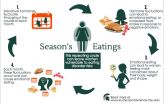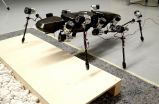Do caffeine's effects differ with or without sugar?
2014-12-16
(Press-News.org) New Rochelle, NY, December 16, 2014-Consuming caffeinated or sugary drinks can affect the body's metabolism, causing changes in heart and respiratory rate and weight gain. The results of a new study exploring whether individuals respond differently to caffeinated drinks that do or do not contain sugar and to sugar alone are published in Journal of Caffeine Research: The International Multidisciplinary Journal of Caffeine Science, a peer-reviewed publication from Mary Ann Liebert, Inc., publishers. The article is available free on the Journal of Caffeine Research website at http://online.liebertpub.com/doi/full/10.1089/jcr.2014.0023 until January 16, 2015.
The article entitled "Caffeine With and Without Sugar: Individual Differences in Physiological Responses During Rest", by Elaine Rush, PhD and coauthors, Auckland University of Technology (Auckland, New Zealand), describes a study in which heart rate and carbon dioxide production (as a measure of respiration) were measured 30 minutes before and after individuals consumed a defined quantity of sugar, caffeine, or sugar and caffeine. Responses to the different treatments varied widely among individuals.
"Given the caveat that sugar itself affects brain reward just as caffeine does, and this effect will in itself cause variations, this is still an essential paper for the scientist and the lay person to read," says Patricia A. Broderick, PhD, Editor-in-Chief of Journal of Caffeine Research, Medical Professor in Physiology, Pharmacology & Neuroscience, The Sophie Davis School of Biomedical Education, The City College of New York, The City University of New York, and Adjunct Professor in Neurology, New York University Langone Medical Center and Comprehensive Epilepsy Center.
INFORMATION:
About the Journal
Journal of Caffeine Research: The International Multidisciplinary Journal of Caffeine Science is a quarterly journal published in print and online. The Journal covers the effects of caffeine on a wide range of diseases and conditions, including mood disorders, neurological disorders, cognitive performance, cardiovascular disease, and sports performance. Journal of Caffeine Research explores all aspects of caffeine science including the biochemistry of caffeine; its actions on the human body; benefits, dangers, and contraindications; and caffeine addiction and withdrawal, across all stages of the human life span from prenatal exposure to end-of-life. Tables of content and a sample issue may be viewed on the Journal of Caffeine Research website at http://www.liebertpub.com/jcr.
About the Publisher
Mary Ann Liebert, Inc., publishers is a privately held, fully integrated media company known for establishing authoritative peer-reviewed journals in many promising areas of science and biomedical research, including Breastfeeding Medicine, Journal of Medicinal Food, and Journal of Child and Adolescent Psychopharmacology. Its biotechnology trade magazine, Genetic Engineering & Biotechnology News (GEN), was the first in its field and is today the industry's most widely read publication worldwide. A complete list of the firm's 80 journals, books, and newsmagazines is available on the Mary Ann Liebert, Inc., publishers website at http://www.liebertpub.com.
[Attachments] See images for this press release:

ELSE PRESS RELEASES FROM THIS DATE:
2014-12-16
Eliminating health disparities between races is a goal of many groups and organizations, but a team of sociologists suggests that finding the reasons for the differences in the timing of black and white deaths may be trickier than once thought.
Life expectancies for black people are shorter and more uncertain, on average, than to those of whites, according to Glenn Firebaugh, Roy C. Buck Professor of American Institutions and professor of sociology and demography, Penn State. A higher lifespan variability -- the variability in the ages at which people die -- among blacks ...
2014-12-16
Unauthorized immigrants who previously have been removed from the United States are more than 2.5 times more likely to be rearrested after leaving jail, and are likely to be rearrested much more frequently than those who have never been removed, according to a new RAND Corporation study.
The findings generally support strategies adopted by federal immigration authorities and some law enforcement agencies to focus their immigration enforcement efforts on immigrants who previously have been removed, who are viewed as posing a bigger criminal threat.
Researchers studied ...
2014-12-16
Unlike in mathematics, it is rare to have exact solutions to physics problems.
"When they do present themselves, they are an opportunity to test the approximation schemes (algorithms) that are used to make progress in modern physics," said Michael Strickland, Ph.D., associate professor of physics at Kent State University.
Strickland and four of his collaborators recently published an exact solution in the journal Physical Review Letters that applies to a wide array of physics contexts and will help researchers to better model galactic structure, supernova explosions ...
2014-12-16
The genetic abnormality that drives the bone cancer Ewing sarcoma operates through two distinct processes - both activating genes that stimulate tumor growth and suppressing those that should keep cancer from developing. These findings by Massachusetts General Hospital (MGH) investigators, published in the November issue of Cancer Cell, may lead to new therapies targeting these aberrant mechanisms.
The second most common bone cancer in children and young adults, Ewing sarcoma is caused by a chromosomal translocation - switching of genetic segments between two different ...
2014-12-16
EAST LANSING, Mich. - 'Tis the season of plenty of food and drink. While celebrating should be joyful, for some women, it's not. All the holiday temptations can add another layer to an already complicated biological process.
It's well known that women undergo hormonal changes every month due to the menstrual cycle. These changes can cause women to eat more, which is a natural, biological occurrence.
However, Michigan State University Foundation Professor Kelly Klump has found that the increased food intake causes some women to become much more preoccupied with their ...
2014-12-16
ITHACA, N.Y. - In the fight against global warming, carbon capture - chemically trapping carbon dioxide before it releases into the atmosphere - is gaining momentum, but standard methods are plagued by toxicity, corrosiveness and inefficiency. Using a bag of chemistry tricks, Cornell materials scientists have invented low-toxicity, highly effective carbon-trapping "sponges" that could lead to increased use of the technology.
A research team led by Emmanuel Giannelis, the Walter R. Read Professor of Engineering in the Department of Materials Science and Engineering, has ...
2014-12-16
HOUSTON -- (Dec. 16, 2014) -- In one of the most comprehensive laboratory studies of its kind, Rice University scientists traced the uptake and accumulation of quantum dot nanoparticles from water to plant roots, plant leaves and leaf-eating caterpillars.
The study, one of the first to examine how nanoparticles move through human-relevant food chains, found that nanoparticle accumulation in both plants and animals varied significantly depending upon the type of surface coating applied to the particles. The research is available online in the American Chemical Society's ...
2014-12-16
This news release is available in German. A research team at Bielefeld University has succeeded in teaching the only robot of its kind in the world how to walk. Its first steps have been recorded in a video. You can watch them in Bielefeld University's latest posting on 'research_tv'. The robot is called Hector, and its construction is modelled on a stick insect. Inspired by the insect, Hector has passive elastic joints and an ultralight exoskeleton. What makes it unique is that it is also equipped with a great number of sensors and it functions according to a biologically ...
2014-12-16
DURHAM, N.C. - Duke University scientists have developed new forensic tracers to identify coal ash contamination in water and distinguish it from contamination coming from other sources.
"These new tools can be used by federal and state regulatory agencies to monitor the environmental effects of coal ash and determine whether it has or hasn't impacted the environment," said Avner Vengosh, professor of geochemistry and water quality at Duke's Nicholas School of the Environment. "They can be used to trace the coal ash effluents to their source, even in watersheds where ...
2014-12-16
Washington, D.C.--New work from Carnegie's Ivan Naumov and Russell Hemley delves into the chemistry underlying some surprising recent observations about hydrogen, and reveals remarkable parallels between hydrogen and graphene under extreme pressures. Their work is the cover story in the December issue of Accounts of Chemical Research.
Hydrogen is the most-abundant element in the cosmos. With only a single electron per atom, it is deceptively simple. As a result, hydrogen has been a testing ground for theories of the chemical bond since the birth of quantum mechanics ...
LAST 30 PRESS RELEASES:
[Press-News.org] Do caffeine's effects differ with or without sugar?




